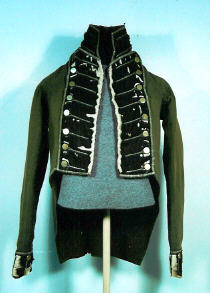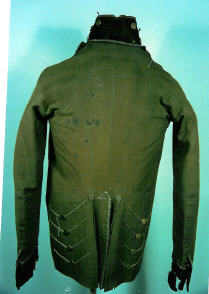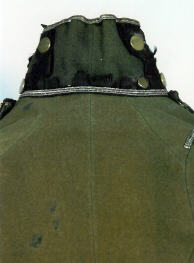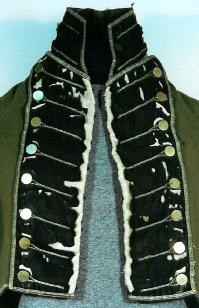Our sites:
Home
of
Access Heritage Inc (formerly The Discriminating General)
The Napoleonic Wars Collection
Military Music Sound Clip Gallery
Products and Services:
British Army Products 1793-1815
British Army Products 1816-1856

Articles - Reenactments and Units - Book Reviews - Quizzes - Replicas - Links - Chart of British Regiments - Sound Clips - Prints for Sale - Animated GIF Battles - Chronology of Events - Video Clips
U.S. Rifle
Uniforms and Canadian Rifle Companies: An Examination of Lt. Levi Soper's
Coat
by Robert Henderson


Front and Rear view of the Soper
coat (Fort York, Heritage Toronto)
A curious War of 1812 Canadian Militia officer’s coat was acquired by Heritage Toronto back in 1986. This coat was worn by Lieutenant Levi Soper of the Rifle Company of the 2nd Regiment Leeds Militia while serving in the defence of the upper St. Lawrence River.
The coat itself is unusual because it’s cut and construction is that of the American Army. A careful examination of the war situation along the St. Lawrence and coat itself will help to solve this mystery.
Canadian Militia Rifle Companies
Prior to the war, British officials determined that rifles were not versatile enough for fighting in the wooded tracks of North America. Therefore newly raised fencible regiments such as Glengarry Light Infantry and the Canadian Voltiguers were outfit with smooth bore muskets. In fact the only British units in North America that carried rifles served in offensive attacks along the coast of the United States.
The American rifleman tradition had a limited impact on Canadian arms preference. Its greatest impact would have been in Upper Canada (Ontario) with its population made up mostly of loyalists from the American Revolution and settlers emigrating from the United States.
In Upper Canada only five companies of militia riflemen were formed:
1st
Leeds Militia Rifle Company (upper St. Lawrence River)
2nd Leeds Militia Rifle Company (upper St. Lawrence River)
1st York Militia Rifle Company (Toronto)
1st Oxford Militia Rifle Company (Western District/Detroit
Frontier)
1st Kent Militia Rifle Company (Western District/ Detroit
Frontier)
This left the vast majority of militia regiments without rifle companies at all. Many of these Rifle militia officers played notable roles in the war. For example, Captain Reuben Sherwood of the 1st Leeds, served at both the battles of Ogdensburg and Crysler’s Farm and was famous for his spying activity on the American side of the river. Officers from the 1st York, 1st Oxford and 1st Kent served at the famous capture of Detroit and some of the offensive operations into Ohio.
How these rifle companies were clothed, armed and accoutred is unknown. British rifles were not in numerous supply at the opening of the war. However, noted in stores at Halifax, Nova Scotia were 357 English and 71 Dutch rifles. These rifles were deposited there after the American Revolution and the English rifles would likely have been the 1776 model and possibly some Ferguson rifles. It was possible some of these rifles made it Upper Canada. That said it is likely the majority would have brought their own personal rifle to the militia musters.
At the opening of the war, there was little military clothing for the Upper Canadian militia and often would have appeared with their civilian attire. A selection of green and red military coats slowly made their way into the militia’s hands, but what was issued to the rifle companies is unknown. Accoutrements would have been whatever was in stores, which included anything leftover from the American Revolution.
War on the Upper St. Lawrence
Soper’s 2nd Leeds Militia was raised and served in the area of Gananoque and Elizabethtown (Brockville) along the St. Lawrence River in the Thousand Islands. Unfortunately for the 2nd Leeds, their first military experience was a humbling one. On September 21st, 1812 Captain Benjamin Forsyth with 82 US Riflemen and some militia landed at Gananoque with the intension of capturing ammunition stores. Forsyth was met by a detachment of about 100 men of the 2nd Leeds deployed into line, half of them wearing redcoats from the military stores in Kingston. After an ineffective volley from the 2nd Leeds, Forsyth’s regulars charged and routed the Canadians.
Forsyth was to embarrass the Leeds Militia a second time, this time the 1st Leeds, when a raid of Elizabethtown was undertaken in early February 1813. After dispersing the militia and emptying the jail, Forsyth returned across the frozen St. Lawrence to his base of operations, Ogdensburg, NY. with a number of prisoners.
It is interesting that Forsyth raiding activities were directed at Leeds county. Of all the counties along the St. Lawrence, Leeds was considered the least committed to the war. In 1814, Lieutenant General Gordon Drummond saw Leeds as “a part of the country infested by swarms of disaffected people who are constantly in the habit of communicating with the enemy in spite of all our vigilance.”
Frustrated with Forsyth’s activity, British and Canadian forces from Prescott attacked Ogdensburg on February 22nd, 1813 by a spirited charge across the frozen St. Lawrence. The US garrison was poorly prepared with most of the men gathering their rations, likely wearing fatigue dress. After an hour and a half of fighting, Forsyth and his riflemen were put to flight and the New York militia subdued. While on his retreat to Sackett’s Harbor, Forsyth, without his sword and bullet holes in his hat and coat, wrote a request to that garrison’s commander: “If you can send three hundred men, all shall be retaken – and Prescott too – or I will loose my life in the attempt.” Forsyth’s request was denied.
After the Battle of Ogdensburg, Forsyth’s sword became a war trophy and today is on display at Fort Wellington National Historic Site in Prescott. But that was not the only trophy. Ogdensburg was pillaged and all its military stores were confiscated and transported back across the ice. Since the garrison were likely in their fatigues, and the officers were “making their toilet” it is possible a number of militia and regular uniforms and equipment fell into British hands.
Lieutenant Soper’s Rifle Coat
The plundering of Ogdensburg may be how Lieutenant Soper of the 2nd Leeds got his coat. Use of captured American uniforms by the militia was documented in an order later in May: “Col. Pearson is much surprised that any officer in the district should appear in the dress of an American Rifleman…” Since Pearson was stationed in Grenville County, the reference to “district” in the order may be a reference to the Leeds rifle companies, which were part of the district he commanded.

The construction of the coat also supports that it was captured. The coat is made of bottle green cloth, similar in manufacture to other American cloths, with black velvet facings. While the green has faded, the original shade can be seen through the holes in the black velvet facings. Since bottle green had begun to be adopted by US rifle corps only in 1812, the coat was probably quite new at the time of the Battle of Ogdensburg. Because the coat had lapels and was decorated with silver ¼ inch vellum lace and silver button twist, it is suspected to be New York rifle militia coat.
This assumption is supported by the fact the US Regular Rifle officers were ordered to wear single-breasted coats in early 1812 which were trimmed with gold. However a surviving NY militia rifle coat of the Trojan Greens mimicked closely the regulars with gold trimmings and black facings, which was against State regulations. Obviously great indulgences were given to rifle companies and it is likely the Soper coat was simply from another NY militia unit.

It being a captured coat is supported by the fact that all the buttons, originally possibly bearing NY militia insignia, have been replaced with plain gilt buttons. Consumer goods in Upper Canada were quite limited and replacing the buttons with silver ones likely was not an option. Aside from this minor change, the specimen is a fine example of US Rifle Officer coats of the time. The coat has short tails which indicates its previous owner was a company officer.
Today the coat is in the reserve collection of Fort York in Toronto. Hopefully it was find its way into a display case in the not-too-distant future so all can enjoy this intriguing coat and its colourful history.
Copyright: Unless otherwise noted, all information, images, data contained within this website is protected by copyright under international law. Any unauthorized use of material contained here is strictly forbidden. All rights reserved.

